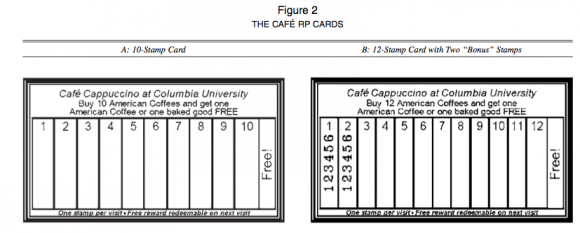Ran Kivetz, Oleg Urminsky i Yuhuang Zheng opisali w 2006 roku badanie, którego celem było zbadanie skuteczności “iluzji postępu” (illusion of progress). W ramach eksperymentu, 108 klientom kawiarni wręczono karty lojalnościowe, które umożliwiały otrzymanie darmowej kawy/wypieku po zebraniu 10 pieczątek. Badani otrzymali dwa typy kart: z 10 polami do wypełnienia oraz z 12 polami, gdzie dwa pierwsze pola zostały już wypełnione. Klienci, którzy otrzymali kupony z 10 polami, zbierali średnio pieczątki po 16 dniach, a ci którzy dostali 12 polowe kupony – średnio po 13 dniach, czyli zdecydowanie szybciej.
Method. The participants were 108 customers of the café we described previously. They were randomly assigned to either a control condition or an experimental (illusionary goal progress) condition. Specifically, research assistants posing as café employees randomly offered customers either a 10-stamp or a 12-stamp coffee card (…). The 10-stamp and the 12-stamp cards indicated that members were required to accumulate 10 and 12 coffee purchases, respectively, to earn one free coffee. However, customers assigned to the 12-stamp experimental condition received two preexisting bonus stamps, described as an offer to anyone who opted to join the program. Thus, although the two groups faced identical effort requirements when joining the program (i.e., r – nt = accumulating 10 coffee purchases), the experimental group started with a lower proportion of original distance remaining to the goal than did the control group (i.e., dt+2 = .83 and dt = 1.0, respectively). All other aspects of the program were held constant across the two conditions and were identical to those we described previously for the café RP.
Results. Consistent with H2, the results indicate that illusionary goal progress led to faster completion of the reward requirement. On average, customers in the control condition completed the ten required purchases (for the 10-stamp card) in 15.6 days. In contrast, customers in the experimental (illusionary goal progress) condition completed the ten required purchases (for the corresponding 12-stamp card) in only 12.7 days, nearly three days or 20% faster (t = 2.0, p < .05; medians = 15 versus 10 days; Z = 2.1, p < .05 [Mann–Whitney U test]).
Źródło: The Goal-Gradient Hypothesis Resurrected: Purchase Acceleration, Illusionary Goal Progress, and Customer Retention, Ran Kivetz, Oleg Urminsky, Yuhuang Zheng Journal of Marketing Research, Vol. XLIII (February 2006), 39–58, American Marketing Association






Recent Comments